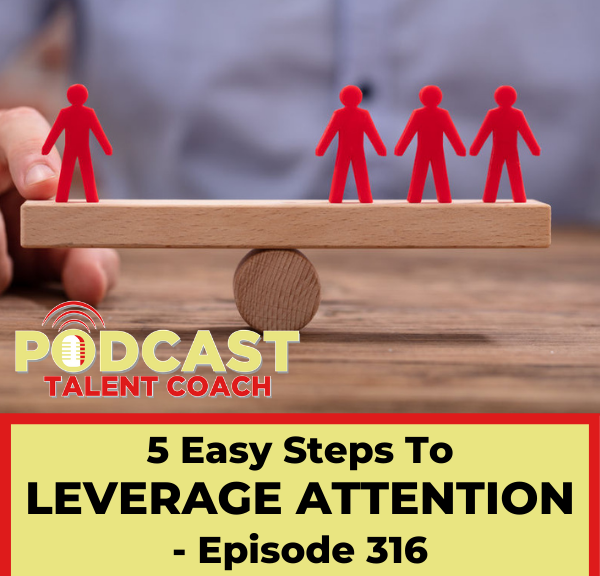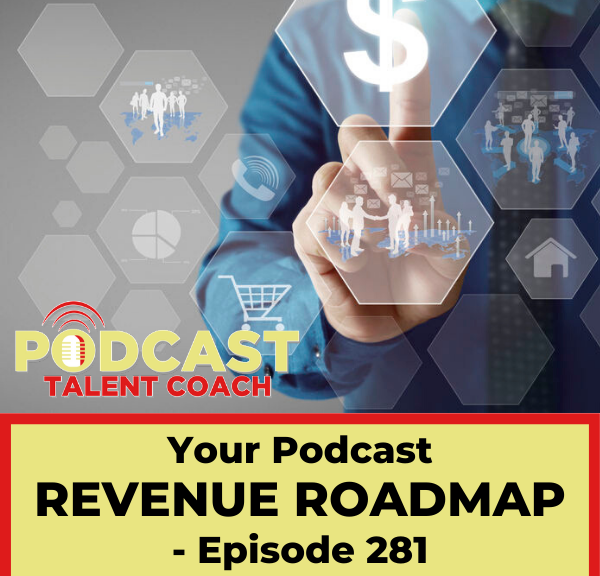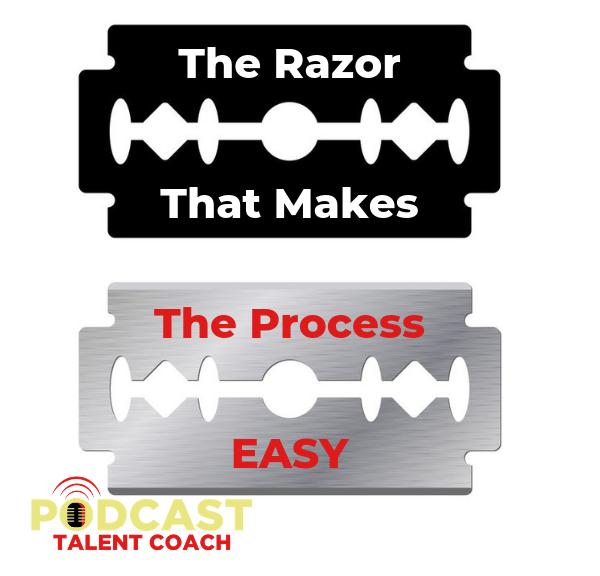Podcast: Play in new window | Download
Subscribe:
Are you ready to take the information you share on your podcast and turn it into a product you can sell? Would you like to make a some money with your show, generate revenue and monetize all of that hard work.
Today, we are going to lay out the roadmap from your content creation to your monetization. Without a plan, it will be difficult to reach your goal.
Imagine being able to leverage all of that great content you are creating each week, use it to attract an audience and then have them buy your information product to help you generate some revenue. That’s the plan we will create today.
EVENT THAT CHANGED MY LIFE
Last weekend, I attended a virtual event that changed my life. I know that sounds over the top. But, it’s true.
It was called JVX Live and was put on by the guys over at Joint Venture Insider Circle. The link is in the show notes at www.PodcastTalentCoach.com/podcasts.
Have you ever met a person who showed you what is possible and exactly how to get there? You thought, “Wow! How did I not know about this?” That’s what happened.
Over the years, I have been climbing the hill step-by-step and learning a ton. At this event, it felt like I jumped on the learning gondola that supercharged my growth like you wouldn’t believe.
Here, I was surrounded by people who coach just like me. During the event, we would be split into small groups of 8 where we could talk about what we did and meet the other people. We were all looking for great business relationships.
PARTNERS
Of the 300 people in attendance, I was eventually in small groups with about 80. Out of those 80, I found 40 that I personally spoke with who might make great affiliate and joint venture partners for me. It was fantastic.
We all shared ideas and helped each other grow. It was amazing. Now over the past week, I have been on the phone and Zoom calls talking with these people, learning so much and discovering how we might help each other.
The connections were so energizing. Every time I would tell someone I help coaches and experts demonstrate their expertise and attract their ideal clients with a podcast, they would say, “Oh, I have 3 or 4 people to introduce you to.”
The power of the collective mind is amazing. In addition to meeting and learning, I have found a ton of free resources for you that I will be sharing over the coming weeks. The sphere has just grown exponentially. And, you get to benefit from all of it. How great is that?
Before we get into creating your podcast revenue road map, I want to give you three incredible, free resources that are going to help you immensely in this journey. They are all at www.PodcastTalentCoach.com/roadmap.
FREE GUIDE
The first resource is my free guide “Six Ways To Make Money With A Free Podcast.” This guide will give you some great ideas along with a dozen examples.
FREE SHOPPING CART
The second is a free shopping cart. If you want to sell digital products online, you need a system that can be your checkout page and deliver the goods.
This is where I really struggled when I started. I didn’t understand the difference between your shopping cart and your payment processor. Your shopping cart is where people come to shop for your goods and buy them. The payment processor is like PayPal or Stripe. That is the system that actually processes the payment. You link the two together to sell your digital products.
Now, you can get this shopping cart for free. It is called GrooveSell and it has been developed by Mike Filsaime.
Mike is a digital marketer. He helped build Video Genesis, one of the first digital products I ever bought back in 2013. Over the years, he helped build WebinarJam, EverWebinar, Kartra and others. He is amazing.
He has now built an amazing shopping cart platform that rivals One Shopping Cart, Infusionsoft, Ontraport, Samcart and others. It even has affiliate systems built in that are similar to ClickBank and JVZoo.
GrooveSell is usually $99/month just like the others. However, he has given me an affiliate link that will allow you to get it for free for life.
What’s the catch? First, he wants to help a ton of people during this crazy time. So the offer is for a limited time. He also wants people to test drive the system and report any bugs. Mike wants to make sure it is perfect before his big rollout. You can help him and in return get the system for free.
THE FEATURES
The link for GrooveSell is also on the page at www.PodcastTalentCoach.com/roadmap.
With GrooveSell, you get:
– Unlimited Products and Funnels
– Flexible Pricing Structures
– Powerful checkout options
– The most powerful Affiliate software on Earth
– Dynamic thank you pages
– Upsells, Downsells, and Order Bumps
– 1-Click Upsell
– Robust Integrations
– No Monthly Fees
– ZERO transactions fees
And, you can use your own PayPal, Stripe or other account.
There are other products Mike sells in the suite. However, this one is free for you with no “gotchas”. Check it out at www.PodcastTalentCoach.com/roadmap.
COLLABORATION CIRCLE
The final opportunity is also free. It is a way for you to find partners to help you grow just like I did. Where my event last weekend was 3 days, this event is once per week for 2 hours. You get in small groups and see how you can help promote each other and grow. Make it on the weeks you can.
The group is call Collaboration Circle. It is free to join. You can find my referral link at www.PodcastTalentCoach.com/roadmap.
Three great, free resources that will help you get on this path. Get them while you can.
YOUR REVENUE ROADMAP
Now, let’s talk about your own Podcast Revenue roadmap. We need to define your goals before these tools will help you get there. The key is to start with the end in mind and work our way back to build our roadmap.
Look into the crystal ball 12 months from today. Where would you like to be? How many downloads? What would you like to be selling and how much would you like to be making?
WHAT IS FEASIBLE?
Now, let’s take those numbers and see if that is feasible.
Let’s say you would like 1,000 downloads per episode and making $100,000 per year. Some tasty numbers.
Where are you today? Maybe 120 downloads per episode and $0 as an example.
So, if we do the math we see we need to grow your downloads by 880, or about 17 new downloads each week. What can you do to find 20 new listeners this week while keeping the listeners you already have? That doesn’t sound so difficult. It just takes consistent action. 4 new listeners a day.
To hit $100,000, we also need to create $8,333 per month or about $1,925 per week. That might be a little more challenging. What can you offer your audience that they would buy?
WHAT CAN YOU CREATE?
Think of the things in your niche that you have purchased. Directories, lessons, software, books, accessories, tip sheets, apps, instructions, resource guides. If you are like me, you probably have a bookshelf or file on your computer full of them.
What could you create and sell at a reasonable price that your audience wants and needs? Digital products are the best. You do the work once and make the sale over and over again. No inventory. There is no additional production. Every new sale is almost pure profit.
If you could create a digital product that sells for $20, you would need to sell 97 per week to hit your $100k. That’s pretty steep.
What if you created a $100 course? Could you sell 19 of those per week? Still a pretty big hill. This is why you need to work backwards into your numbers. $100k sounds great. However, you need the audience to convert to sales.
Could you create a $497 group coaching program and enroll 2 people per week? Combine that with 6 sales of your $100 course and 20 copies of your $20 step-by-step guide. Now you’re talking $103,000 per year. Find your sweep spot and spend time there.
START THEIR JOURNEY
Once you have defined what your audience wants and needs to solve their problems, what free item could you give them to start them on their journey.
Ideally, each level builds on the previous level. Your lead magnet, or free piece of content, would be a small sliver of your digital product. It could be a free chapter of your book or one particular step of your process. This gets your listeners started on the path to see what is possible.
Lead magnets solve one specific problem. We talked about this in detail in episode 235. Check it out if you need help here.
Where you lead magnet gives your listener a taste, you $20 step-by-step guide shows them the full process and teaches them “what to do”.
Your digital product shows your listener “what to do”, your $100 course shows your listener “how to do it”.
The course is part of your group coaching. Your course shows them “how to do it”. Then, your coaching then helps people implement your how-to course.
It climbs the value ladder. Each rung of the ladder offers a higher level of help with a little higher price tag.
YOUR PODCAST
So, how does your podcast fit into all of this? Your content is the step right before the lead magnet.
On your podcast, teach your listener what is possible. Here, we are showing you what is possible with your show in terms of generating revenue.
It just like like me showing you what is possible with selling your digital products. Then, I send you to my website to get my “Six Ways To Make Money With a Free Podcast.” The lead magnet solves one specific problem. It helps you come up with a way digital product you can create and sell.
Start with the end in mind and work your way back to your content. Once you have the group coaching defined, turn that into a course. Peel off a piece to create a digital product. Use little pieces of the digital product for various lead magnets. Then, use each lead magnet for an episode.
If you talk about Jeeps, create a way for Jeep enthusiasts to find the best off-roading in every state.
Let’s say you talk teaching piano. Create a way to learn 3 of your favorite songs in 30 days.
If you talk genealogy, create a program that teaches people how to track their family tree and hold a huge family reunion.
Do you talk bullying? Create a program that teaches parents how to help their kids develop strong self confidence.
If you love music history, create an affiliate program that helps people visit the historic musical sites around the country.
GET STARTED
Start creating your roadmap. Once you have your plan created, you will know exactly what you need to talk about on your show.
Get those free resources at www.PodcastTalentCoach.com/roadmap.
Let’s get started today. Most importantly, enjoy the journey.
You can find my podcast and other tools to help you create great content at www.PodcastTalentCoach.com.
Let’s turn your information into engaging entertainment.
- Links may be affiliate links. If you make a purchase through one of these links, I may make a commissions. However, I only recommend products and services I believe in and trust. Monetary numbers are examples only. No promises or guarantees are being made. Demonstration purposes only.



